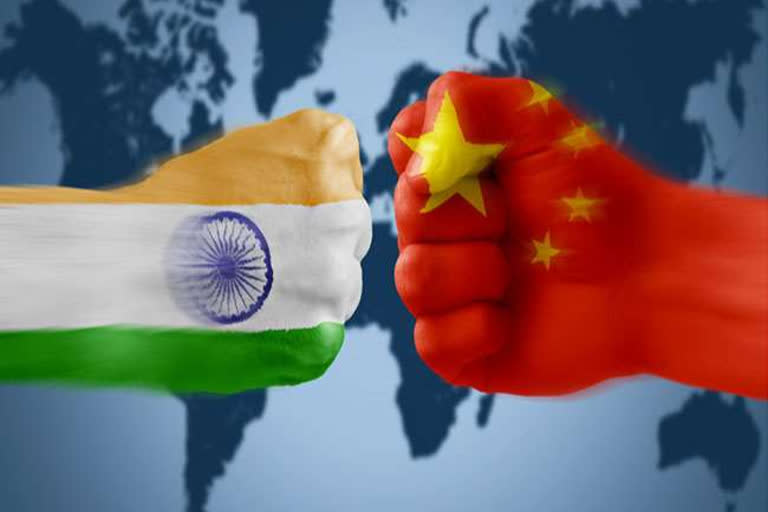New Delhi: China’s step up in belligerence against Indian soldiers in Ladakh on Tuesday and in north Sikkim on Saturday doesn’t afford a commentary on the strange relationships the two Asian giants share.
Possibly also because of the fact that the two nations - with the world’s two largest armies - cannot afford a conflict at this point of time or even in the near future.
The relationship hasn’t entirely been an unpleasant one despite efforts of global powers to pit the Indian elephant against the Chinese dragon.
For instance, despite many accusing fingers being pointed at China blaming it for the outbreak of the coronavirus pandemic, India has till now refrained from passing judgement.
On May 1, Chief of Defence Staff (CDS) General Bipin Rawat had also put a restraining hand with his crisp statement, “It is not proper to conclude that the novel coronavirus outbreak is the result of a biological warfare.”
ETV Bharat had earlier reported that on Saturday, fisticuffs took place between patrolling soldiers of the Indian Army soldiers and the PLA near the 5,000 metre altitude Naku La pass in north Sikkim, injuring soldiers from both sides.
Defence sources also confirmed a similar incident in the north side of the Pangong Tsa lake in eastern Ladakh where soldiers of the two militaries confronted each other leading to a fistfight that injured a few.
A military official said, “The incident involving a total of about 150 men from both sides has a fracas that began on Tuesday late afternoon and spilt over to Wednesday morning. It was resolved locally.”
A serving Indian army officer earlier deployed in north Sikkim and also near Ladakh told ETV Bharat on condition of anonymity, “Such incidents are not extraordinary. They keep on happening from time to time. It takes just a single hot-blooded soldier on either side to spark it off. Not much should be read into such brawls.”
“The entire area is a high-altitude plateau where there are no permanent stations. Our soldiers patrol it like the PLA. Many a time, the patrols come across each other and the two teams depart often after exchanging pleasantries and even cigarettes and chocolates.”
Read: Sikkim border fisticuffs no test of poised India-China relationship
Confirming Saturday’s incident, a spokesperson of the Indian Army’s Eastern Command said, “Temporary and short duration face-offs between border guarding troops do occur as boundaries are not resolved… Aggressive behaviour by the two sides resulted in minor injuries to troops.”
Both India and China have been careful not to let such fracas affect bilateral ties.
Significantly, four months back in the second week of January, top military officials from the Indian Army’s Northern and Eastern Commands - the designated commands facing the Chinese frontier - visited China and met their PLA counterparts in an effort to further strengthen the existing border dispute resolution mechanism.
One reason why there has been a step up in border flare-ups is because Indian Army patrol teams now can cover considerable distances by vehicles, which was not the case earlier. Like China’s roads, the Indian government is pursuing a plan to build roads right up to the LAC.
Most of the routine Border Personnel Meets (BPM)—a mechanism to defuse unwanted situations over frequent transgressions and border incidents—are also marked with marked warmth.
The local commanders of the two armies meet at five designated points along the border at Daulat Beg Oldie (Ladakh), Spanngur Gap (Ladakh), Bum-La (Arunachal Pradesh), Nathu-La (Sikkim) and Kibithu (Arunachal Pradesh).
Such BPMs have come in handy in preventing such incidents blow up into Doklam like face-offs.
Also located across Sikkim, the Doklam plateau saw the two sides facing each other in a 73-day-long stubborn standoff in 2017 before mutual de-escalation.
The major reason for such border incidents—numbering hundreds every year—is because of the enigma that is the LAC. Both the Indian Army and the PLA have their own perception of where the LAC lies.
While India abides by the McMahon Line, drawn in 1914, China has refused to formally acknowledge the McMahon Line and accordingly lays claim to 65,000 sq km of territory in Arunachal Pradesh which it calls “Southern Tibet”.
The imaginary line was drawn on the basis of alignment with the mountain crest in the region in accordance with the watershed principle and in many places the McMahon Line and the mountain crest line does not align.
The Indo-China straddles five states - Arunachal Pradesh (1,126 km), Uttarakhand (345 km), Jammu and Kashmir (1,597 km), Himachal Pradesh (260 km) and Sikkim (198 km).
Also Read: Nepal reacts strongly to China's state-run CGTN tweet over Mount Everest



